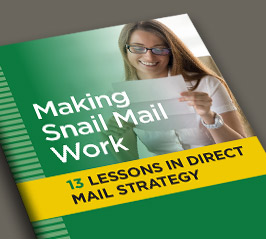
Direct Mail Response Rates and More
How to assess the performance of your direct mail campaigns
It’s the bottom line of your direct marketing program. It’s how you assess the performance of your direct mail campaign? It’s how you measure your ROI (return on investment).
Understandably, it’s what everyone wants to know going into a new campaign.
It all starts with the response rate
You send out 5,000 mailers and get 50 responses back. That’s a 1% response rate – and a pretty decent response in today’s world.
The benchmark used to be 2%, but the Internet has changed everything and we are now seeing that 2% rate become 1%. That’s because, in our view, much of the information we has always offered in our direct mail campaigns can now be acquired very easily with a Google search.
But these numbers only apply under certain conditions
Response rates can never be promised, but with enough experience, you can establish some level of expectation under very specific conditions.
The 1% rate described above would only apply when you are running a lead generation campaign with an informational offer using a cold third-party mailing list. But …
If you are running a direct sales campaign, expect those numbers to drop down to .001 or .002.
If you are running a lead generation campaign with a higher engagement offer (such as a free consultation or similar appointment, that 1% is likely to drop to .004 or .005.
If you are running any type of program using your own list of past responses or actual customers (the so-called House List), you can look at much more than response rates – up to 5 or 10 times higher than using a cold list.
But the response rate is just the beginning
Response rates give you good first read of your mailing, but if you only rely on your response rate, you are missing some very important analytical data. A couple of examples:
What if you run two separate direct mail campaigns – one costing $5,000 and the other costing $8,000 -and they both produce an identical 50 response? Same raw response, same response rate but a very different cos-per-response ($100 vs. $160).
What if you run two separate direct mail campaigns – at the same cost – and they both produce 50 responses. But after you follow-up, you can see that one campaign produced many more qualified leads. Here you want to look at the qualitied lead rate or cost-per-qualified lead.
You can (and should) do a similar analysis for every step in your sales process.
How to measure your direct mail campaigns

Looking at your entire sales process
It is only natural that when we measure direct mail, we look at the initial numbers first – and, depending on how your mailer was created, that might include both informational responses as well as higher-engagement responses such as appointment requests, or free consultation requests or quote requests.
These are responses that come in directly from the direct mail.
But you cannot (should not) overlook the impact the direct mail is going to have AFTER the initial responses come in … after you have followed up with a phone call … after you have started to send follow-up emails. This could take weeks or months, but this is information that needs to be tracked and collected.
We do this by mapping out your sales process and then adding numbers to each step in the process. Here’s an example of a simple sales process. (Yours may different)
For the purposes of this discussion, we have added numbers to this chart to help illustrate how this would work. Your numbers will vary.

Comparing direct mail with other marketing activities
When you look at your direct mail results, you will inevitably try to compare those results with what you may be seeing with other marketing campaigns.
Afterall, the goal is to find the most efficient way to sell your products and services.
Be careful with the terminology
Where this can become a little confusing is in the terminology we use for different campaigns.
In direct mail, we refer to the response rate, but in digital marketing, they don’t have the same metric. they have open rates, click-through rates and conversion rates (click to lead conversions).
So, when you are comparing direct mail with digital advertising, it’s best to avoid these terms and instead use “cost-per” comparisons like a cost per lead or cost per qualified lead.
Let’s start with a chat
If it looks like we can help you, let’s get acquainted. Just a brief chat would do – maybe 15 or 20 minutes.
Click here to schedule a call (or Zoom meeting). Or call 508-473-8643 (M-F/9-5/Eastern).


